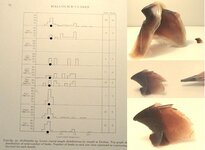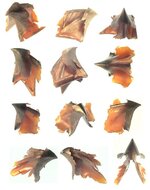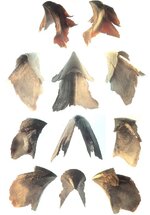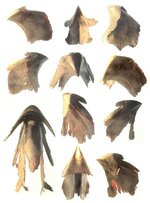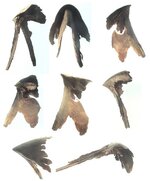- Joined
- Nov 19, 2002
- Messages
- 4,674
This rather poor scan (something in prep) is of the upper and lower beaks of Pholidoteuthis boschmai . The upper illustrations are from a female (lower beak, left; upper beak, right), and the lower illustrations from the male (lower beak, left; upper beak, right).
Pholidoteuthis is generally thought to be quite a rare squid (although some 30+ mature specimens exist in the collections - probably more than anywhere else). Two 'forms' have been referred to in the literature - long and short rostrum. In redescribing this species (in prep - some major changes to be made) we determined the 'long rostrum' form was simply the male, and the 'short rostrum' form the female.
I've included these pics, and will include pics of others shortly, to emphasise that there's a lot of variation in beak shape within a species, between sexes, and sometimes ontogenetically. In other words, identifying beaks, often partially digested, from stomach contents isn't exactly an 'exact science', and we still know very little of the biology and morphometric/anatomical variation of these deep-sea squid species.
What is REALLY interesting is that almost every beak recovered from the stomachs of these sperm whales to date has been male (long rostrum form). Bizarre!
Pholidoteuthis is one of a very few species of squid that is almost exclusively found on seamount/deep-sea reef habitat in New Zealand waters. Interesting ay what! (Are the whales eating on seamounts/reef?)

Pholidoteuthis is generally thought to be quite a rare squid (although some 30+ mature specimens exist in the collections - probably more than anywhere else). Two 'forms' have been referred to in the literature - long and short rostrum. In redescribing this species (in prep - some major changes to be made) we determined the 'long rostrum' form was simply the male, and the 'short rostrum' form the female.
I've included these pics, and will include pics of others shortly, to emphasise that there's a lot of variation in beak shape within a species, between sexes, and sometimes ontogenetically. In other words, identifying beaks, often partially digested, from stomach contents isn't exactly an 'exact science', and we still know very little of the biology and morphometric/anatomical variation of these deep-sea squid species.
What is REALLY interesting is that almost every beak recovered from the stomachs of these sperm whales to date has been male (long rostrum form). Bizarre!
Pholidoteuthis is one of a very few species of squid that is almost exclusively found on seamount/deep-sea reef habitat in New Zealand waters. Interesting ay what! (Are the whales eating on seamounts/reef?)

 ). It's way cool to see it, after all of this time!
). It's way cool to see it, after all of this time! I'll just have to come over one of these days, have a few beers, then go take a peek at it together.
I'll just have to come over one of these days, have a few beers, then go take a peek at it together.